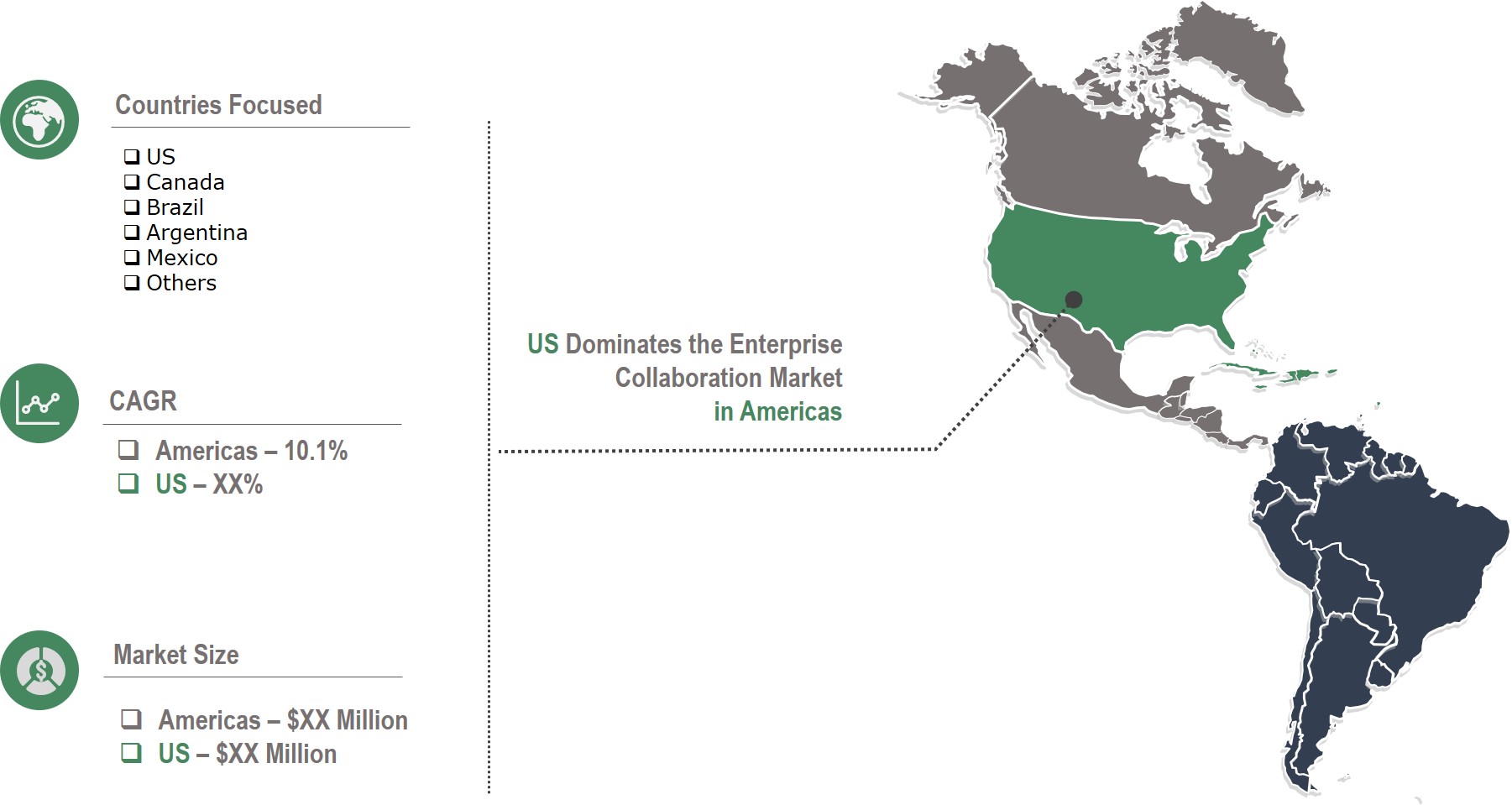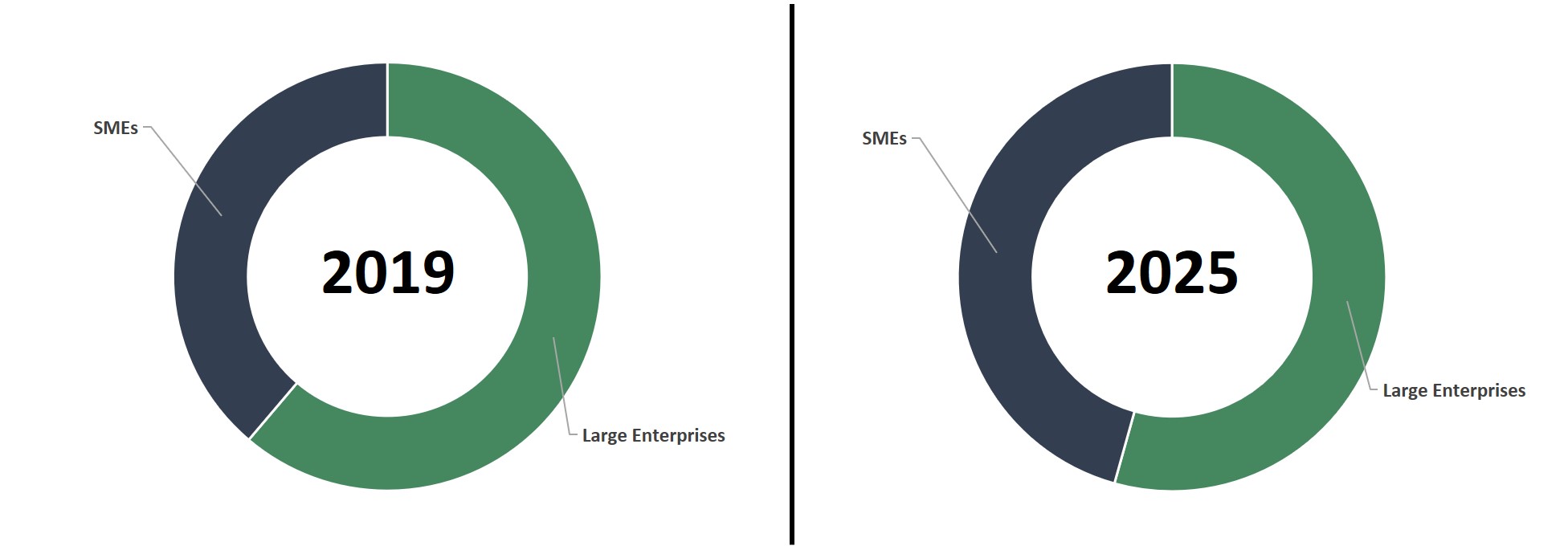
Americas Enterprise Collaboration Market Forecast 2019–2025
- Domain: ICT - Software & Services
Enterprise collaboration is a communication platform commonly used to create a collaborative environment that enables employees to work together in an efficient and productive way. The enterprise collaboration platform enables businesses to integrate the capabilities, skills, and expertise of the workforce, unites them in a common purpose and structure. Based on the requirements, the enterprise collaboration platform can be deployed, either on-premises or deployed, via the web-as-cloud-based services. The enterprise collaboration platform includes web conferencing, email client, video capabilities, instant messaging, document sharing capabilities, and others. Typically, enterprise collaboration can be broadly classified into team collaboration, communication, writing/editing, and networking/engaging.
Market Dynamics – Americas Enterprise Collaboration Market
An increasing number of virtual teams coupled with the rising focus to create a collaborative work environment are the key factors contributing to the growth of the Americas enterprise collaboration market. An increasing number of projects, such as smart cities and connected vehicles, involves multiple partnerships that require an integrated suite of tools, which support cross-enterprise coordination and communication. An increase in the number of such projects is accelerating the growth of the Americas enterprise collaboration market during the forecast period.

Increasing investments in streamlining business processes and rising preference for an integrated suite of tools, instead of operating multiple applications, are further propelling the growth of the Americas enterprise collaboration market. However, lack of awareness about the potential benefits of enterprise collaboration solutions and concerns related to return of investment are identified as restraints likely to deter the progression of the Americas enterprise collaboration market during the forecast period.
Market Segmentation – Americas Enterprise Collaboration Market
The Americas enterprise collaboration market is segmented based on component, deployment mode, organization size, industry vertical, and by country. By component, the Americas enterprise collaboration market is segmented into software and services. The software segment is sub-segmented into messaging, audio and video, file sharing, intranet and portal, enterprise social network, and project and calendar management. The services segment is sub-segmented into support & services, implementation & integration, and consulting.
By deployment mode, the Americas enterprise collaboration market is segmented into on-premises and cloud. By organization size, the Americas enterprise collaboration market is segmented into large enterprises and SMEs. By industry vertical, the Americas enterprise collaboration market is segmented into manufacturing, BFSI, telecom and IT, government, consumer goods, and retail, and others.

Country-level Outlook – Americas Enterprise Collaboration Market
By Country, the Americas enterprise collaboration market is segmented into U.S., Canada, Brazil, Argentina, Mexico, and Others. Among other countries, the US dominates the overall Americas enterprise collaboration market and is anticipated to maintain its market dominance throughout the forecast period. This is mainly due to increasing investment in developing a collaborative work environment to enhance productivity and tool to connect the workforce with information and resources in a secured platform.
Benefits and Vendors – Americas Enterprise Collaboration Market
The study on the Americas enterprise collaboration market contains an in-depth analysis of vendors, which includes financial health, business units, key business priorities, SWOT, strategies, and views; and competitive landscape. Few of the key players profiled in this study include Microsoft, Salesforce, IBM, Cisco Systems, Facebook, Slack, Smartsheet, Jive Software, Deskera, and Tibco Software.
The study offers a comprehensive analysis of the “Americas enterprise collaboration market”. Bringing out the complete key insights of the industry, the report aims to provide an insight into the latest trends, current market scenario, and technologies related to the market. In addition, it helps the venture capitalists to understand the revenue opportunities across different segments to take better decisions.
- Industry Outlook
- Industry Overview
- Industry Trends
- PEST Analysis
- Report Outline
- Report Scope
- Report Summary
- Research Methodology
- Report Assumptions
- Market Snapshot
- Total Addressable Market
- Segmented Addressable Market
- Related Markets
- Market Outlook
- Overview
- Porter 5 (Five) Forces
- Market Characteristics
- Evolution
- Market Segmentation
- Market Dynamics
- Drivers
- Restraints
- Opportunities
- DRO – Impact Analysis
- Components: Market Size and Analysis
- Overview
- Software
- File Sharing
- Messaging, Audio and Video
- Enterprise Social Network
- Intranet and Portal
- Project and Calendar Management
- Services
- Implementation and Integration
- Support and Maintenance
- Consulting
- Deployment Mode: Market Size and Analysis
- Overview
- On-premises
- Cloud
- Organization Size: Market Size and Analysis
- Large Enterprises
- SMEs
- Verticals: Market Size and Analysis
- Market Size and Analysis
- BFSI
- Manufacturing
- Telecom & IT
- Government
- Healthcare & Life Sciences
- Consumer Goods & Retail
- Energy and Utilities
- Others
- Country: Market Size and Analysis
- Overview
- US
- Canada
- Brazil
- Argentina
- Mexico
- Others
- Vendor Profile
- Microsoft
- Salesforce
- IBM
- Cisco Systems
- Companies to Watch for
- Slack
- Tibco Software
- Smartsheet
- Jive Software
- Deskera
- Competitive Landscape
- Competitive Comparison Analysis
Annexure
Abbreviations
Research Framework
Infoholic Research works on a holistic 360° approach in order to deliver high quality, validated and reliable information in our market reports. The Market estimation and forecasting involves following steps:
- Data Collation (Primary & Secondary)
- In-house Estimation (Based on proprietary data bases and Models)
- Market Triangulation
- Forecasting

Market related information is congregated from both primary and secondary sources.
Primary sources
Involved participants from all global stakeholders such as Solution providers, service providers, Industry associations, thought leaders etc. across levels such as CXOs, VPs and managers. Plus, our in-house industry experts having decades of industry experience contribute their consulting and advisory services.
Secondary sources
Include public sources such as regulatory frameworks, government IT spending, government demographic indicators, industry association statistics, and company publications along with paid sources such as Factiva, OneSource, Bloomberg among others.






